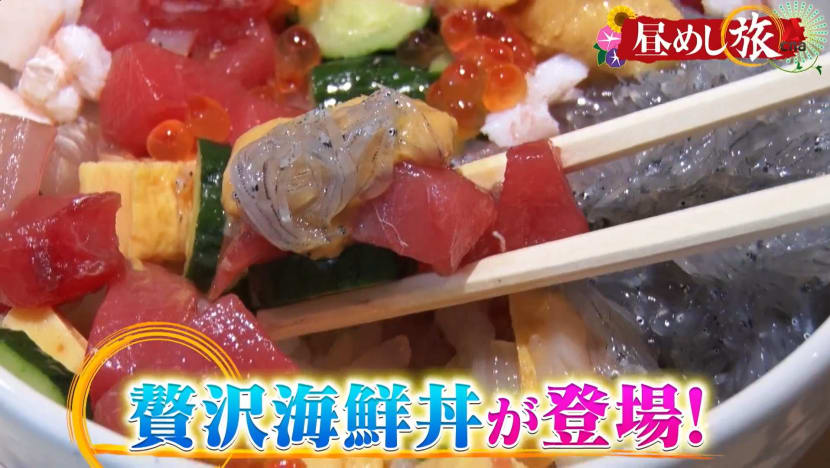It's Lunchtime - Fukuoka and Ishikawa prefectures
Our culinary investigation of what people in Fukuoka and Ishikawa prefectures eat for their meals uncovers interesting and unique local delicacies such as gameni and a sushi roll with pufferfish.

Our culinary adventure this week takes us to two cities. We first visit Fukuoka City in Fukuoka Prefecture to investigate what people eat. This time, we will find out what store or restaurant employees have for their meals. We start by exploring the area around Hakata Station in Fukuoka. We go to Yanagibashi Rengo Ichiba, which was established about 100 years ago. The locals call this market "the kitchen of Hakata" as it boasts about 40 shops, mainly fresh fish stores.
We walk around the market and see items like spicy cod roe mixed with natural kelp from Rausu, Hokkaido; yuzuika, which goes well with sake or rice; and sashimi-grade squid with yuzu pepper. We then leave the market and go to Kaneo Shoyu, a soy sauce brewer with more than 100 years of history. Its most popular product is a dipping sauce for noodles. We meet the store’s manager, Yoshiko Kogushi, who agrees to show us how the dipping sauce is made. Ingredients like dried small sardines and kelp are used to make the broth. We request to see the dishes prepared for the restaurant staff’s lunch. They include stir-fried takana, somen noodles and gameni, Fukuoka’s local delicacy. It features root vegetables seasoned in Kyushu's famous flying fish broth. The vegetables are stir fried with chicken before being cooked in the freshly made speciality dipping sauce. Another dish is kashiwa rice made with chicken, burdock roots and carrots. The dipping sauce is once again used to cook the rice.
Our next stop in Fukuoka is a fish shop called Ogihara Sengyoten. It was founded in 1882 and is currently run by the sixth-generation owner. It moved to its current location in a residential district 10 years ago. The shop sells fresh seafood from the coast of Fukuoka and Kyushu. Its processed products made from fresh fish are also popular, getting orders from all over Japan. Examples are dried mackerel seasoned with mirin, conger eel from Tsushima, grunt and natural sea bream caught in Kanezaki.
We watch the shop’s owner preparing lunch for his staff. One dish is sesame and horse mackerel rice bowl. He first fillets the horse mackerel caught in the Tsushima Strait and removes its small bones. He then adds soy sauce, sake, mirin and sesame to the finely chopped horse mackerel and mixes the ingredients well. The sesame and horse mackerel bowl is finally topped with chopped perilla leaves. The owner also makes pressed sushi with seasonal mackerel, one of the shop’s popular products, with about 500 pieces being sold each month. It includes kelp from Hokkaido which is soaked in sauce and placed on top of the mackerel. The employees’ meal also includes dried mackerel seasoned with mirin and conger eel sashimi served with ponzu sauce.
Our next food investigation takes us to Hakusan City in Ishikawa Prefecture. It faces the Sea of Japan and thus boasts lots of fresh fish and shellfish throughout the year. We visit a popular morning market, Kitokito Asaichi, next to the Mikawa fishing port. We meet Hirozaku Ito, who is buying flounder, filefish, horse mackerel and red squid. A cook with nearly 40 years of experience, he owns a sushi restaurant called Mihama near the fishing port. It opened in Hakusan City about three years ago and its most popular dish is Mikawa Kenichi Don. Ishikawa Prefecture has the largest haul of pufferfish in Japan so Mr Ito recommends the restaurant’s speciality sushi roll made with pufferfish, sweet shrimps and perilla.
For his employees’ meal, he makes a seafood rice bowl topped with raw whitebait, yellowtail amberjack, red squid, bluefin tuna, horse mackerel, sea urchin and crab. He also adds a special sauce - consisting of soy sauce and other seasonings - which is mixed with cucumber and eggs.
Our next stop in Hakusan City is Komaiko Beach, chosen as one of the best 100 beaches in Japan. Here, we meet an Ama diver who has just caught rock oysters. A diver of 10 years, Kayo Hamabe tells us that oysters from this area are particularly large and have a creamy, rich flavour. We also learn that sea diving has a long history, dating back more than a thousand years. We watch Ms Hamabe cleaning and sorting the rock oysters she just caught. She removes the seaweed from the shells and washes them thoroughly. She then sorts them by size and takes them to the market.
Ms Hamabe wakes up at 3am every day and goes fishing, using fixed nets. She comes back home and later catches rock oysters during the day as it is her hobby. She agrees to show us her dinner at her house. We meet her son and her husband, who is also a fisherman. For dinner, she cooks her speciality pork curry with vegetables such as carrots, onions and green peppers from her garden. The meal includes a local dish of Ishikawa Prefecture called nikoboshi - pickled radish simmered with soy sauce and mirin. Other dishes are spinach and dried radish boiled and seasoned with soy sauce, red squid sashimi and whelk cooked in soy sauce.
Tips:
1) A must-try delicacy of Fukuoka is gameni, or simmered vegetables with chicken
2) Komaiko Beach in Hakusan City is said to be one of Japan’s 100 best beaches












